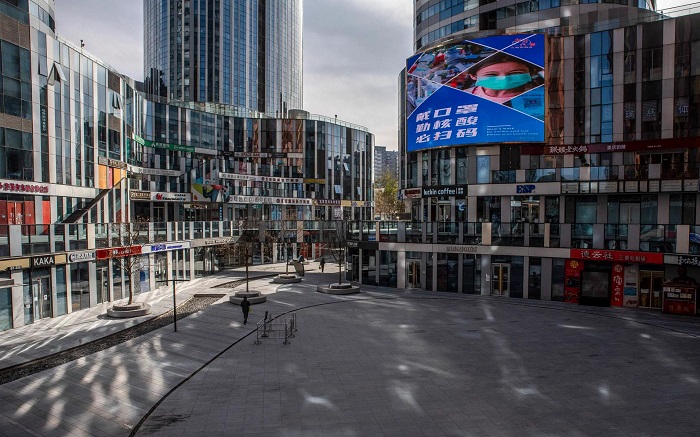
Nearly three years of snap lockdowns, business upheaval and volatile travel restrictions under China’s stringent zero-Covid policy have pushed people to their mental and financial limits while having an outsized impact on the nation’s economy.
With lives and livelihoods on the line, many people are frustrated, angry and confused – pondering the continued validity of an unwavering strategy that was designed to protect the most vulnerable in society from infections while keeping economic activities humming along.
While most of the world has moved on and reopened, Chinese people have only slowly started to see an easing of controls. Many are eagerly awaiting a return to normality as Beijing’s old playbook on coronavirus controls increasingly appears unsustainable.
In the southwest border province of Yunnan, Cun Xiaoqin had to lay off most of the staff at her travel agency and a small hotel after intermittent restrictions brought business to a standstill.
She said she was scared but remained hopeful when travel was halted in early 2020, and her hope appeared justified as she ended up turning a profit during the first year of the pandemic, due to an eventual resumption of domestic tourism after initial lockdowns.
Back then, China was the only major economy to see its economy expand, with 2.2 per cent growth in 2020, but it still marked the nation’s lowest gross domestic product (GDP) increase in nearly half a century.
Then the coronavirus mutated, eventually becoming less severe but more transmissible as the fast-spreading Omicron variant took hold. All the while, China’s pandemic-control measures remained in full force.
“We were confused and scared at first, then we were angry, and now we have become used to it – like how people adapt to hopeless situations,” Cun said. “We are not going to be able to last for much longer.”
Much like tourism, the services industry has been buffeted by outbreak-induced lockdowns and bans on dining in restaurants throughout China.
Nearly half a million restaurants closed from January to November. And in the first six months alone, the number of cancelled restaurant registrations exceeded the total from all of 2020, according to Qichacha, which provides data and analytics on China-based companies.
Even the livelihoods of nomadic herdsmen in the far-flung western autonomous region of Xinjiang have been affected, with lockdowns and travel restrictions delaying their seasonal migrations to winter pastures. At least seven people and hundreds of livestock were killed when a cold snap and blizzard conditions swept through last month.
Desperate Chinese farmers across the country have also been forced to destroy crops in order to grow new vegetables in time, as regional virus controls have restricted travel through many rural areas.
Early during the pandemic, Chinese people largely seemed to support the nation’s zero-Covid strategy, when the virus was seen as more dangerous, and before vaccinations had been created.
China’s system of strict lockdowns and mass testing helped rein in deaths and infections while the pandemic disrupted the global supply chain, dragged down major global economies and caused millions of deaths, especially among seniors.
But tolerance appears to be waning, as evidenced by anger and frustration boiling over last month in a number of cities following a deadly fire in Xinjiang, with demonstrators believing that antivirus measures had prevented firefighters from saving lives – an allegation that authorities denied.
Nonetheless, the incident has served to fuel public criticism of Beijing’s costly zero-Covid policy.
The crux of the issue, according to Yuen Yuen Ang, an associate professor of political science at the University of Michigan, is that the policy hasn’t allowed for the changing nature of Covid-19, nor for living with the virus.
“Instead, its focus – even after the 20 measures were introduced – is to stamp out Covid. This is simply not feasible,” she said, referring to the central government’s directives laid out last month to loosen its zero-Covid policy while easing the financial burden on local governments.
But those measures instead led to varying and confusing implementations at local levels. And daily infections have since reached record highs, with rampant outbreaks in major cities such as Beijing, Shanghai, Guangzhou, Chongqing and Wuhan prompting a further tightening of coronavirus restrictions, rather than an expected easing.
The purpose behind this shift remains unclear, according to Larry Hu, chief China economist at Macquarie Group.
“Is it to bring the [number of] new Covid cases back to the level seen one month ago? Or is it to slow the spread of the virus – i.e. flatten the curve – to mitigate the disruptions on hospitals and the economy,” Hu questioned.
“Without clear guidance from the top, local officials are inclined to play it safe by sticking to the existing zero-Covid stance. This upset many people who expected more loosening following the ‘20 measures’.”
Meanwhile, the economic costs of zero-Covid keep piling up, becoming more and more apparent as the policy curtails GDP. In March, Beijing expected that the economy would grow by 5.5 per cent this year, but that’s no longer the case after second-quarter growth tumbled to 0.4 per cent, year on year, and third-quarter growth came in at 3.9 per cent.
Goldman Sachs estimated in May that testing 70 per cent of the population every two days would cost as much as US$370 billion, or 2.2 per cent of China’s economic output last year.
And Soochow Securities estimated that the cost of regular coronavirus tests in all first- and second-tier cities could reach 1.7 trillion yuan (US$239 billion) a year, accounting for 8.7 per cent of public expenditures, or 1.5 per cent of China’s 2021 GDP.
Public health expenditures across the country also topped 7.2 trillion and 7.5 trillion yuan in 2020 and 2021, respectively – a two-year total that nearly matched the 15.8 trillion yuan spent from 2016-18.
Meanwhile, with local governments struggling under the burden of increased coronavirus-related expenditures, their revenues have been slashed by a property sector slump and because of tax rebates that they must dole out in line with the central government’s repeated calls for local support to be given to virus-hit businesses.
With business activity suffering such a blow, the nation’s unemployment rate has also remained high this year, reflecting the impact on ordinary people’s lives. In October, the urban unemployment rate was 5.5 per cent, while the rate for those aged 16 to 24 was 17.9 per cent.
Official data has also signalled falling retail sales, weak investment figures, shrinking factory activity and dim property sales.
And air traffic in China this week dropped to 20 per cent of what was seen during the same period in 2019, as the number of new cases rose and travel restrictions continued, according to Chinese aviation data provider Flight Master.
Even if zero-Covid ends, China could see a delayed recovery in both consumption and its property sector, as well as in other distressed sectors, according to Chim Lee, a China analyst with the Economist Intelligence Unit (EIU).
“Successive years of talent migration and subpar economic performance also risk leaving a permanent scar on China’s long-term growth potential,” he warned.
The fiscal costs of controlling the more contagious Omicron variant are much higher, and the systems necessary to do so are more onerous, said Logan Wright, a partner at Rhodium Group who leads the firm’s China Markets Research work.
“As Covid defences gradually break down and more people are infected, service sector industries, employment and household consumption are likely to suffer, which [could] produce a contracting economy in the months ahead,” Wright said.
A government adviser who spoke on condition of anonymity said China is losing its advantage in battling the pandemic, while economic costs are rising as the situation becomes increasingly unfavourable.
“The current concern is that, if the pandemic doesn’t disappear next year, will we maintain the current control measures,” he questioned. “We can’t stop people from travelling, and there will always be new infections. It’s not worth it to spend so much economically and socially to prevent infections.”
However, these types of calls for a reopening are often met with opposition from those who point to potential pitfalls, including a relatively low vaccination rate among elderly Chinese citizens, as well as a lack of ICU units in hospitals, especially in smaller cities.
Without such protections, China’s underprepared medical system is at risk of being overwhelmed by mass infections.
A full reopening could lead to millions of people being admitted for intensive care, while China currently has fewer than four ICU beds per 100,000 people, according to Bloomberg Intelligence senior pharmaceuticals analyst Sam Fazeli.
The National Health Commission has responded by urging local governments to build more hospital beds – ranging from temporary quarantine hospitals for less severe infections to ICU beds for life-threatening cases.
“Although China has improved its critical care capacity since the pandemic began, most measures have targeted resource mobilisation, such as building makeshift hospitals in localities with outbreaks, and recruiting medical personnel to the region,” said Lee with the EIU. “We do not see this strategy as effective against an uncontrolled nationwide outbreak.”
However, some experts argue that, for now, China’s current coronavirus-control measures are the best option.
“In the beginning, the costs of opening up will be more significant compared with being closed up,” said Cui Ernan, a China analyst with Beijing-based Gavekal Dragonomics.
However, given drastic policy changes in recent days, as some cities began allowing cases to surge, she contends that “the government’s sequence of decisions has now left it with no good choice but to accept a forced reopening, which points to a messy muddle-through approach in the coming months”.
“It remains uncertain how fast they’ll manage the reopening process, and to what extent they will loosen restrictions step by step. Things are just changing more dramatically now.
“Higher levels of cases will effectively be tolerated, some restrictions will be maintained in some places to continue to slow the spread, and there will hopefully be an accelerated effort to prepare the healthcare system and improve vaccination rates.” (SCMP)

